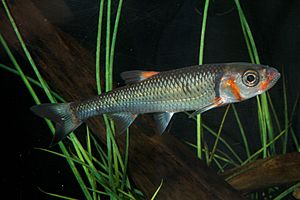Warpaint shiner facts for kids
Quick facts for kids Warpaint shiner |
|
|---|---|
 |
|
| Conservation status | |
| Scientific classification | |
| Synonyms | |
|
The warpaint shiner (Luxilus coccogenis) is a type of freshwater fish found in North America. It lives in the upper Tennessee River basin. You can also find it in the Savannah River, the Santee River, and the New River in North Carolina. Adult warpaint shiners are usually about 9 cm (3.5 in) long. They can grow up to 14 cm (5.5 in). These fish usually live for about 4 years.
Warpaint shiners like to live in cool streams with rocky bottoms. They eat small insects that live in the water. They also catch insects that fall onto the water's surface. These shiners are a food source for bigger sport fish like smallmouth and largemouth bass. The warpaint shiner is also very important for tiny baby freshwater mussels. It helps the endangered Tennessee heelsplitter mussel grow up.
Contents
Where Warpaint Shiners Live
Warpaint shiners first lived only in the Tennessee River area. But people have moved them to other rivers, like the Upper Savannah, Santee, and New River. They like clear, cool water in creeks, streams, and rivers. They eat aquatic insects there.
These fish usually live for two to four years. During this time, they grow to be about 65 mm to 95 mm long.
Life Cycle and Reproduction
Warpaint shiners become old enough to have babies when they are two years old. They usually start spawning in their third summer. Spawning means laying eggs. This happens in May and June.
They lay their eggs in clear, fast-moving water. They often use the round rock nests built by another fish called the river chub. Groups of eight to ten male shiners will hover over the nest. The biggest male is usually at the front. Females come from behind the males. Then, a male and female pair up and go into a small crack in the rocks. There, they release their sperm and eggs. Other males might crowd around to try and fertilize the eggs too.
After the eggs are laid, the parents do not take care of them. Each time they spawn, they can produce from 300 to 1600 baby fish. Warpaint shiners in the wild live for about four years. Some have lived a little longer when kept in tanks.
What Warpaint Shiners Eat
Adult warpaint shiners are found in rocky parts of fast-moving creeks. They like cool, clear, small to medium-sized rivers and streams. They eat mostly insects. In the spring, they use their big mouths to eat insect larvae that live in the water. These include mayfly nymphs. In the summer, warpaint shiners mostly eat insects that fall onto the water's surface. These insects include beetles.
Who Eats Warpaint Shiners
Largemouth bass and smallmouth bass are the main fish that eat warpaint shiners. Warpaint shiners are often found swimming together in small schools with other small fish.
How Warpaint Shiners Help Mussels
The warpaint shiner is very important for the Tennessee heelsplitter mussel. This mussel is endangered, meaning it's at risk of disappearing. Baby mussels, called larvae, need to attach to the gills or fins of a fish to grow up. The warpaint shiner acts as a "host" for these baby mussels. This means the mussels attach to the shiner and get a ride while they grow.
Mussel populations have been hurt by human activities. Building dams and pollution from farming can harm their homes. Because freshwater mussels are very endangered in North America, protecting fish like the warpaint shiner is super important for the mussels to survive.
Protecting Warpaint Shiners
Right now, there are no special plans just for the warpaint shiner. But they are a "special concern" in some areas like Alabama and South Carolina. Overall, their numbers are stable.
The biggest dangers to warpaint shiners are things that hurt their habitat. This includes cutting down trees near rivers, dirt washing into the water (called siltation), and building dams. These problems affect many other stream fish too. Protecting the warpaint shiner helps keep many other fish healthy.
See also
 In Spanish: Luxilus coccogenis para niños
In Spanish: Luxilus coccogenis para niños


